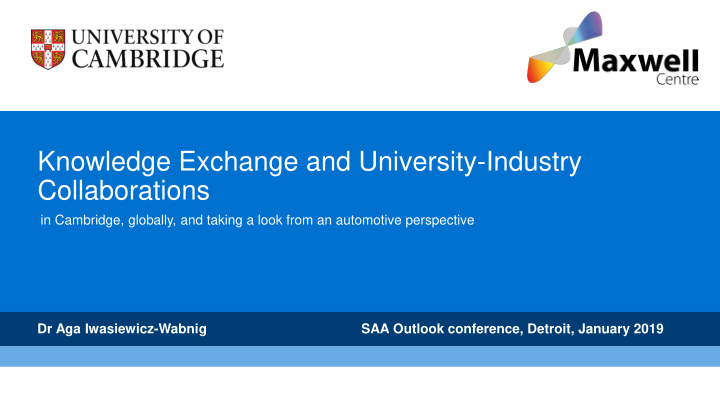



Knowledge Exchange and University-Industry Collaborations in Cambridge, globally, and taking a look from an automotive perspective Dr Aga Iwasiewicz-Wabnig SAA Outlook conference, Detroit, January 2019
University’s Mission The mission of the University of Cambridge is to contribute to society through the pursuit of education, learning, and research at the highest international levels of excellence.
Cambridge in numbers Cambridge gave the world: Discovery of electron, neutron and photon, determination of DNA structure, Newton’s laws and Maxwell’s equations, evolution (Darwin), the first programmable computer and the Raspberry Pi, inhalers, Concorde droop nose, pacemakers, heart and liver transplants, Clearblue pregnancy test, Maris Piper potato, ARM chip, smart meters, gene sequencers, Bluetooth (CSR), Cambridge Consultants, the Cambridge satchel, F1 inerter, organic LEDs, antibody drugs, the Monty Python crew, Venn diagrams, in-vitro fertilisation, antimatter, first ever flushing toilet, jet engines … … and we do not stop at that.
There are many tested models for collaboration with industry joint projects, Shared access Impact equipment Acceleration grants Strategic Consultancy and partnerships access to experts PhD studentships; Secondments Engagement framework Forums agreements embedded laboratories, research University contracts Technology Centres industrial residence or hotdesk in the Maxwell Centre spin-outs and IP licensing pump-priming initiatives
Automotive innovation has to integrate across traditional sector boundaries
Automotive innovation has to integrate across traditional sector boundaries Meaningful partnerships & knowledge transfer?
Globally unique environment – capable of true multidisciplinarity Arts, Humanities and Social Sciences Addenbrooke’s Medical West Cambridge Science and Data security Research Campus Technology Campus Alan Turing Institute for Data Science Public Health, Neuroscience, Human Machine Learning Cardiovascular, interaction Immunology & more Safety Centre for Mobile, Wearable Systems and Augmented Intelligence Autonomy Energy efficiency Low-carbon Faraday Institution – batteries research Henry Royce Institute for Advanced Materials Robotics Cutting-edge research and world-leading experts across all areas Europe’s largest technology cluster = University of Cambridge strategic research themes = existing hubs or centres (>100 academics each) = UK national institutes where University of Cambridge is a key partner
Maxwell Centre model Multi £M Carrying out Two way flow of Core focus on A gateway to the investment in world-leading ideas and Physical Sciences University collaborations research researchers and Technology Discovery science Increasing the Multidisciplinary, Sharing offices, meets research direct industrial Acceleration of diverse and laboratories, & objectives relevant involvement in research impacts interconnected meeting space to industrial needs research Access to Space for both facilitation and strategy and knowledge brokers serendipity www.maxwell.cam.ac.uk
The Maxwell Centre – industrial residency benefits • R&D office established at the Maxwell Centre, led by Magna’s Director, Corporate Engineering and R&D • Front seat view and a gateway to the University, earliest possible preview of what’s on the horizon • Constant interaction with company employees: facilitation, collaborations, scheduled meetings, as well as serendipitous chats by the coffee machine • Engagement with University research, the broader Cambridge Cluster, and entrepreneurs: www.maxwell.cam.ac.uk
The Maxwell Centre – academic benefits • Source of interesting problems and research questions to work on • Pathway to delivering research impact through industrial partnerships • Better dissemination of academic work to its prospective beneficiaries • Direct exposure to industrial needs and ways of working – building mutual understanding and trust • Leveraging new funding streams – direct sponsorship, and/or governmental support e.g. through innovateUK • Opposite of an “ivory tower”, detached academia • Stimulating entrepreneurial thinking and aspirations amongst researchers • And more…. www.maxwell.cam.ac.uk
Concluding thoughts • World is changing around us, and it becomes more difficult to anticipate impact of cross-sector innovation. The essence of what a car has been for decades is now rapidly evolving (electrification, autonomy, car transport • as a service, etc…) – there is a lot of open problems looking for system-level solutions, and new knowledge generation is often required: that’s where universities can help! • Automotive companies may need to reach out quite far away from the core expertise and comfort zone of the sector to remain competitive. • University-industry partnerships are worthwhile, especially if collaboration stems from common aims and builds on complimentary strengths. • Working together is not always straightforward, and requires commitment from all sides. Consider knowledge exchange rather than one-directional tech transfer. • Open mind and serendipity help – we all need to be prepared to kiss a few frogs before we find our prince.
Last, but not least… Visit us at NAIAS AutoMobili-D this week! University of Cambridge Booth UA05
Recommend
More recommend